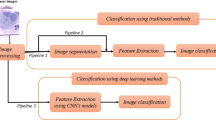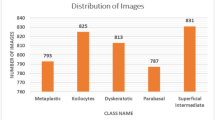Abstract
Cervical cancer is a serious threat to the lives and health of women. The accurate analysis of cervical cell smear images is an important diagnostic basis for cancer identification. However, pathological data are often complex and difficult to analyze accurately because pathology images contain a wide variety of cells. To improve the recognition accuracy of cervical cell smear images, we propose a novel deep-learning model based on the improved Faster R-CNN, shallow feature enhancement networks, and generative adversarial networks. First, we used a global average pooling layer to enhance the robustness of the data feature transformation. Second, we designed a shallow feature enhancement network to improve the localization and recognition of weak cells. Finally, we established a data augmentation network to improve the detection capability of the model. The experimental results demonstrate that our proposed methods are superior to CenterNet, YOLOv5, and Faster R-CNN algorithms in some aspects, such as shorter time consumption, higher recognition precision, and stronger adaptive ability. Its maximum accuracy is 99.81%, and the overall mean average precision is 89.4% for the SIPaKMeD and Herlev datasets. Our method provides a useful reference for cervical cell smear image analysis. The missed diagnosis rate and false diagnosis rate are relatively high for cervical cell smear images of different pathologies and stages. Therefore, our algorithms need to be further improved to achieve a better balance. We will use a hyperspectral microscope to obtain more spectral data of cervical cells and input them into deep-learning models for data processing and classification research.
Graphical Abstract
First, we sent training samples of cervical cells into our proposed deep-learning model. Then, we used the proposed model to train eight types of cervical cells. Finally, we utilized the trained classifier to test the untrained samples and obtained the classification results.
Fig 1. Deep-learning cervical cell classification framework












Similar content being viewed by others
Explore related subjects
Discover the latest articles and news from researchers in related subjects, suggested using machine learning.References
Hoppenot C, Littell RD, DeEulis T et al (2021) Top ten tips palliative care clinicians should know about caring for patients with cervical cancer. J Palliat Med 24(3):438–442
Hurtado E, Cardenas L, Salmeron J et al (2021) Comparative performance of the human papillomavirus test and cytology for primary screening for high-grade cervical intraepithelial neoplasia at the population level. Int J Cancer 150(9):1422–1430
Siegel RL, Miller KD, Jemal A (2022) Cancer statistics, 2022. CA: Cancer J Clin 72(1):7–33
Lew M, Wilbur D, Pantanowitz L (2021) Computational cytology: lessons learned from Pap test computer-assisted screening. Acta Cytol 65(4):286–300
Zheng C, Qing S, Wang J et al (2019) Diagnosis of cervical squamous cell carcinoma and cervical adenocarcinoma based on Raman spectroscopy and support vector machine. Photodiagn Photodyn 27:156–161
Zhao L, Li K, Yang H, et al. (2017) Abnormal cervical cell detection based on an adaptive margin-based feature selection method [C]//Ninth International Conference on Machine Vision ( ICMV2016). International Society for Optics and Photonics 389–393
Sukumar P, Ravi S (2018) Computer aided detection and classification of Pap smear cell images using principal component analysis. Int J Bio-inspired Comput 11(4):257–266
Zhao LL, Li K, Yin JP et al (2017) Complete three-phase detection framework for identifying abnormal cervical cells. IET Image Proc 11(4):258–265
Geetha R, Sivasubramanian S, Kaliappan M et al (2019) Cervical cancer identification with synthetic minority oversampling technique and PCA analysis using random forest classifier. J Med Syst 43(9):1–16
Isidoro D, Carneiro C, Resende M, et al. (2020) Automatic classification of cervical cell patches based on non-geometric characteristics[C]//Proceeding of 15th International Joint Conference on Computer Vision, Imaging and Computer Graphics Theory and Applications 845–852
Diniz DN, Rezende MT, Bianchi AGC et al (2021) A hierarchical feature-based methodology to perform cervical cancer classification. Appl Sciences-basel 11(9):1–16
Zhang L, Lu L, Nogues I et al (2017) DeepPap: deep convolutional networks for cervical cell classification. IEEE J Biomed Health Inform 21(6):1633–1643
Wu M, Yan C, Liu H et al (2018) Automatic classification of cervical cancer from cytological images by using convolutional neural network. Biosci Rep 38(6):1–16
Wang H, Jiang C, Bao K et al (2019) Recognition and clinical diagnosis of cervical cancer cells based on our improved lightweight deep network for pathological image. J Med Syst 43(9):1–9
Khamparia A, Gupta D, de Albuquerque VHC et al (2020) Internet of Health Things-driven deep learning system for detection and classification of cervical cells using transfer learning. J Super Comput 76(11):8590–8608
Wieslander H, Forslid G, Bengtsson E, et al. (2017) Deep convolutional neural networks for detecting cellular changes due to malignancy[C] //Proceedings of the IEEE International Conference on Computer Vision Workshops. Los Alamitos: IEEE Computer Society Press 82–89
Shi J, Wang R, Zheng Y et al (2021) Cervical cell classification with graph convolutional network. Comput Methods Programs Biomed 198:1–17
Almubarak H, Stanley RJ, Rodney Long L et al (2017) Convolutional neural network based localized classification of uterine cervical cancer digital histology images. Procedia Comput Sci 114:281–287
Kawr N, Panigrahi N, Ajay MD (2017) Automated cervical cancer screening using transfer learning. Int J Adv Res Sci Eng 6(8):2110–2119
Fang F, Li L, Zhu H et al (2020) Combining Faster R-CNN and model-driven clustering for elongated object detection. IEEE Trans Image Process 29(1):2052–2065
Huang H, Zhou H, Yang X et al (2019) Faster R-CNN for marine organisms detection and recognition using data augmentation. Neurocomputing 337:372–384
Ren S, He K, Girshick R et al (2017) Faster R-CNN: towards real-time object detection with region proposal networks. IEEE Trans Pattern Anal Mach Intell 39(6):1137–1149
Zhou T, Li Z, Zhang C (2019) Enhance the recognition ability to occlusions and small objects with robust Faster R-CNN. Int J Mach Learn Cyberntetics 10(11):3155–3166
Saxena D, Cao J (2021) Generative adversarial networks (GANs): challenges, solutions, and future directions. ACM Comput Surv 54(3):1–18
Goodfellow I, Pouget-Abadie J, Mirza M et al (2020) Generative adversarial networks. Commun ACM 63(11):139–144
Plissiti ME, Dimitrakopoulos P, Sfikas G, et al. (2018) Sipakmed: a new dataset for feature and image based classification of normal and pathological cervical cells in Pap smear images [C] // 25th IEEE International Conference on Image Processing (ICIP) 3144–3148
Jia D, Li B, Zhang C (2020) Detection of cervical cancer cells based on strong feature CNN-SVM network. Neurocomputing 411:112–127
Bhatt A, Ganatra A, Kotecha K (2021) Cervical cancer detection in Pap smear whole slide images using convNet with transfer learning and progressive resizing. PeerJ Comput Sci 348:1–18
Rahaman M, Li C, Yao Y et al (2021) DeepCervix: a deep learning-based framework for the classification of cervical cells using hybrid deep feature fusion techniques. Comput Biol Med 136:1–12
Pal A, Xue Z, Desai K et al (2020) Deep multiple-instance learning for abnormal cell detection in cervical histopathology images. Comput Biol Med 138:1–12
Yu S, Zhang S, Wang B et al (2021) Generative adversarial network based data augmentation to improve cervical cell classification model. Math Biosci Eng 18(2):1740–1752
Rahaman M, Li C, Yao Y et al (2021) DeepCervix: a deep learning-based framework for the classification of cervical cells using hybrid deep feature fusion techniques. Comput Biol Med 136:1–12
Rehman A, Ali N, Taj I, et al. (2020) An automatic mass screening system for cervical cancer detection based on convolutional neural network, Math Probl Eng 1–14
Wang P, Wang J, Li Y et al (2020) Adaptive pruning of transfer learned deep convolutional neural network for classification of cervical Pap smear images. IEEE Access 8:50674–50683
Sabeena K, Gopakumar C (2022) A hybrid model for efficient cervical cell classification. Biomed Signal Process Control 72:103288
Diniz D, Rezende M, Bianchi A et al (2021) A hierarchical feature-based methodology to perform cervical cancer classification. Appl Sci 11(9):1–19
Hussain E, Mahanta L, Das C et al (2020) A shape context fully convolutional neural network for segmentation and classification of cervical nuclei in Pap smear images. Artif Intell Med 107:1–20
Mas M, Grespo B, Espana R et al (2020) Classifying Papanicolaou cervical smears through a cell merger approach by deep learning technique. Expert Syst Appl 160:1–30
Kuko M, Pourhomayoun M (2020) Single and clustered cervical cell classification with ensemble and deep learning methods. Inf Syst Front 22(5):1039–1051
Aditya K, Deepak G, Rodrigues J et al (2021) DCAVN: cervical cancer prediction and classification using deep convolutional and variational autoencoder network. Multimed Tools Appl 80(20):30399–30415
Ahmed G, Ghulam M, Shamim H (2020) Cervical cancer classification using convolutional neural networks and extreme learning machines. Future Gener Comp Sy 102:643–649
Wang T, Shen F, Deng H et al (2022) Smartphone imaging spectrometer for egg/meat freshness monitoring. Anal Methods 14(5):508–517
Muhle R, Ernst H, Sobottka SB et al (2021) Workflow and hardware for intraoperative hyperspectral data acquisition in neurosurgery. Biomed Eng Biomedizinische Technik 66(1):31–42
Shen F, Deng H, Yu L et al (2022) Open-source mobile multispectral imaging system and its applications in biological sample sensing. Spectrochimica Acta Part A-Molecular and Biomolecular Spectroscopy 280:1–8
Zhang Z, Hu B, Yin Q et al (2019) Optical design and laboratory test of an internal pushbroom hyperspectral microscopy. Modern Physics Letters B 33(12):1–9
Wang J, Sun L, Wang Y et al (2021) Identification of melanoma from hyperspectral pathology image using 3D convolutional networks. IEEE Trans Med Imaging 40(1):218–227
Funding
This work is supported by Major Science and Technology Project of Hainan Province (ZDKJ202006).
Author information
Authors and Affiliations
Corresponding authors
Ethics declarations
Conflict of interest
The authors declare no competing interests.
Additional information
Publisher's note
Springer Nature remains neutral with regard to jurisdictional claims in published maps and institutional affiliations.
Rights and permissions
Springer Nature or its licensor (e.g. a society or other partner) holds exclusive rights to this article under a publishing agreement with the author(s) or other rightsholder(s); author self-archiving of the accepted manuscript version of this article is solely governed by the terms of such publishing agreement and applicable law.
About this article
Cite this article
Xu, L., Cai, F., Fu, Y. et al. Cervical cell classification with deep-learning algorithms. Med Biol Eng Comput 61, 821–833 (2023). https://doi.org/10.1007/s11517-022-02745-3
Received:
Accepted:
Published:
Issue Date:
DOI: https://doi.org/10.1007/s11517-022-02745-3




